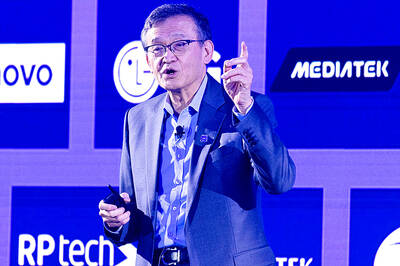Taiwanese smartphone marker HTC Corp (宏達電) formally launched branded products in China late last month, hoping to duplicate its branding success in other markets.
Before the launch, HTC had marketed its products in China under the Dopod brand after acquiring Dopod International Corp (多普達) in 2007, but felt the time had come to promote its own brand.
“We are proud to introduce the HTC brand in China and look forward to bringing a fresh customer-centric smartphone experience to consumers in China,” HTC chairwoman Cher Wang (王雪紅) said.
Analysts caution, however, that China’s market is not likely to become a major contributor to HTC’s revenues anytime soon.
“While we believe China is an important smartphone market, given the sizeable subscriber base, it may not emerge as a key revenue driver for HTC in the next one to two years,” Jeff Pu (蒲得宇), an analyst with Fubon Securities Investment Services Co (富邦投顧) said, in a statement on July 30.
Luke Lin (林俊吉), an analyst with Taipei-based research firm DigiTimes, agreed with Pu and said in a recent e-mail message that so far, revenues from China account for only a very small part of HTC’s total revenues.
From the second half of this year, however, Lin believes Chinese telecoms operators will significantly increase their subsidization and procurement of smartphones, which could begin to have an impact on HTC, the world’s eighth- largest mobile phone maker.
China was the world’s second- largest smartphone market for the sixth consecutive quarter in the second quarter of this year. During that period, 6.9 million smartphones, representing 11 percent of the worldwide total, were sold in China, second only to the US, where 14.7 million units, or 23 percent of global shipments, were sold, research firm Canalys said on Aug. 2.
At an investor conference on July 29, HTC chief financial officer Cheng Hui-ming (鄭慧明) acknowledged that sales in China will not contribute much to total revenues in the third quarter of this year, but said it would be a key future market.
Dopod had only a 1.6 percent share of China’s smartphone market in the first quarter of this year, ranking eighth, falling far behind Apple, which was in sixth place with a 5.4 percent share, according to recent figures from Chinese marketing agency Analysys International.
Nokia is the top smartphone seller in China with a 29.3 percent share, the figures showed.
HTC chief executive officer Peter Chou (周永明), vowed late last month that HTC would become one of China’s top three smartphone brands in the next two or three years.
Kelly Hsieh (謝雨珊) of Topology Research Institute (拓墣產業研究所) recently said that she is optimistic HTC will reach its goal based on similar patterns in the European and North American markets, where it also took two to three years to emerge as a major brand.
Chou recently told reporters that 8 percent of smartphone users in China are aware of HTC, even though HTC has never sold its products there under its own brand.
Chou explained that because many Chinese consumers have owned HTC models through parallel imports — authentic goods imported into a country without the authorization of the brand — the HTC brand already has a good reputation in China.
While some analysts are optimistic about HTC’s prospects in China, daunting challenges still loom, including competition from strong foreign competitors, according to Lin, who said HTC could not ignore Chinese rivals.
Hsieh felt that an increase in cheap knock-offs in China’s market could also present a major hurdle.

The Eurovision Song Contest has seen a surge in punter interest at the bookmakers, becoming a major betting event, experts said ahead of last night’s giant glamfest in Basel. “Eurovision has quietly become one of the biggest betting events of the year,” said Tomi Huttunen, senior manager of the Online Computer Finland (OCS) betting and casino platform. Betting sites have long been used to gauge which way voters might be leaning ahead of the world’s biggest televised live music event. However, bookmakers highlight a huge increase in engagement in recent years — and this year in particular. “We’ve already passed 2023’s total activity and

Nvidia Corp CEO Jensen Huang (黃仁勳) today announced that his company has selected "Beitou Shilin" in Taipei for its new Taiwan office, called Nvidia Constellation, putting an end to months of speculation. Industry sources have said that the tech giant has been eyeing the Beitou Shilin Science Park as the site of its new overseas headquarters, and speculated that the new headquarters would be built on two plots of land designated as "T17" and "T18," which span 3.89 hectares in the park. "I think it's time for us to reveal one of the largest products we've ever built," Huang said near the

China yesterday announced anti-dumping duties as high as 74.9 percent on imports of polyoxymethylene (POM) copolymers, a type of engineering plastic, from Taiwan, the US, the EU and Japan. The Chinese Ministry of Commerce’s findings conclude a probe launched in May last year, shortly after the US sharply increased tariffs on Chinese electric vehicles, computer chips and other imports. POM copolymers can partially replace metals such as copper and zinc, and have various applications, including in auto parts, electronics and medical equipment, the Chinese ministry has said. In January, it said initial investigations had determined that dumping was taking place, and implemented preliminary

Intel Corp yesterday reinforced its determination to strengthen its partnerships with Taiwan’s ecosystem partners including original-electronic-manufacturing (OEM) companies such as Hon Hai Precision Industry Co (鴻海精密) and chipmaker United Microelectronics Corp (UMC, 聯電). “Tonight marks a new beginning. We renew our new partnership with Taiwan ecosystem,” Intel new chief executive officer Tan Lip-bu (陳立武) said at a dinner with representatives from the company’s local partners, celebrating the 40th anniversary of the US chip giant’s presence in Taiwan. Tan took the reins at Intel six weeks ago aiming to reform the chipmaker and revive its past glory. This is the first time Tan